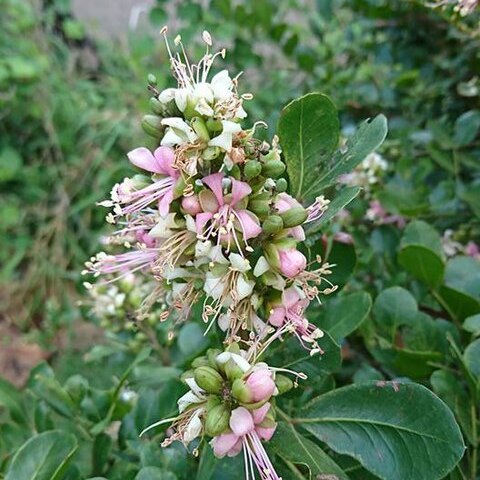A medium to large tree It can grow 12-15 m tall in forest. The bark is smooth and grey or brown. The leaves are 10 cm long by 8 cm wide. They are on stalks 2.5 cm long. The leaves may or may not have hairs. In young leaves the midrib is sometimes slightly winged. There are 3-5 pairs of large oblong leaflets. These are 6.5 cm long by 4 cm wide. The upper leaflets are the largest. The base is lopsided. The tip can be pointed or round. The base can be tapered or round. The flowers are pale pink and usually have 5 petals. They are produced in open bundles at the ends of branches. The pods are 15 cm long. They are hard and round. Inside there are several light brown seeds with a yellow layer around them. The seeds in the green pods are edible.
A small to medium-sized, slender tree 3-10 m in height. Bark: grey to reddish brown, smooth. Leaves: with 3-5 pairs of opposite leaflets; leaflets elliptic-oblong, 2.5-6 x 1.4-3.5 cm; apex tapering to rounded; base tapering to rounded, asymmetric; margin entire; petiole up to 2 cm long. Flowers: much paler than those of the other species, pink to whitish rather than crimson-red, in rather loose, open, terminal heads or panicles, about 8 x 8 cm; petals well developed, up to 2-2.5 cm long. Fruit: a flattened pod, broadly ovate to oblong, about 10 x 4 cm, pale cinnamon-brown, with the characteristic persistent rim which sometimes almost forms a narrow wing. Seeds: oval, flattened, up to 2 cm in diameter, with a large, yellow aril.
Tree, up to 15 m high; crown somewhat rounded. Bark smooth, dull grey to reddish brown. Branchlets glabrous to shortly pubescent. Leaflets 3-5 pairs, opposite, sessile, elliptic-oblong to obovate, base cuneate, apex rounded to acute, oblique, upper leaflets largest. Inflorescence a terminal to lateral panicle, relatively open. Flowers pink to flesh-coloured. Calyx reddish brown, coriaceous; tube very short turbinate, sparingly pubescent; lobes 4, subequal, obovate. Petals 5, veined, oblanceolate. Flowering time Aug.-Feb.
Tree, up to 10 m high. Leaflets (15-)25-65 x 14-35 mm, margins usually glabrous or almost so, petioles 5-20 mm long. Inflorescence a lax panicle. Petals 9-11 mm long. Flowers pink.
Small, slender tree, 3-5 m. Leaves pinnate, leaflet pairs 3-5. Flowers in open panicles, pink to red, filaments united below.


